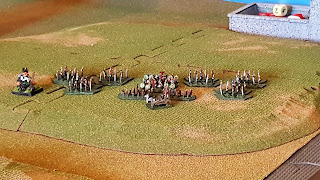The Hares advanced splendidly to the pas de charge.
The battalion deployed into divisions, with the centre pressing forward while the flanks turned outward to face expected resistance.
For their part the Rifles kept up a constant fire, potting the odd rabbit here and there.
Capt. Merciless' gun fired with more success on the Burrovian right. Each time a ball cleared a furrow of fuzzy troops, the gap was filled and the Hares marched on.
Soon the Hare center had reached the stone wall and at close range their vollies sent a company of the Rifes packing.
The Hares had soon cleared the wall and were by default in control of the sunken lane.
About this time I realized that, as Giggers, I had spent too much attention on skirmishing and cannon fire than on positioning my dragoons to threaten the enemy flank.
One squadron was now hurriedly shifted to my right. The Rifles there had sufficiently contained the Burrovian skirmishers, to allow the Horse to threaten the left flank Burrovian division.
On my left, the gun and rifles had reduced the Burrovian right flank division to nearly half. They were ripe for a cavalry charge!
However, here fate stepped in.
The Burrovian commander, no doubt sensing the threat to his right, ordered his centre division across the sunken lane. No doubt he felt secure in his ability to cross the obstacle before I could counter the move.
In that he was sadly mistaken.
Caught in the act of crossing the sunken lane, the Burrovians were no match for the tide of Horseorcs that thundered down on them.
A few Dragoons fell to a Burrovian volley, but with cries of "View Halloo", the Sewon and Soforths ran down their prey.
The centre was routed!
Unable to reign in the Sewon and Soforths pursued in a frenzy of hacking and slashing.
Some orcs and horse were lost jumping the wall but still they came on.
The Burrovian colonel barely got away with the regimental colours.
All the while the Merciless' gun and the Rifles kept the enemy flanks under fire.
I twas too much for Hare to bear and brave but daunted Bunnies retired to their starting line on Hassenhoff Ridge.
So, that was exciting and fun.
As mentioned before this action was based on the American Civil War skirmish at Brinkerhoff Ridge. On the day a regiment of the Stone Wall brigade, only some 300 + strong faced Federal cavalry under Pleasonton. Pleasonton actually had some 900 sabres at his disposal, as well as a section of guns, although how many of his horsemen were actually engaged is not known to me.
However the presence of the guns alone seems reason enough for the Confederate failure. The Rebs aimed to capture the sunken road and hold that line to keep the Federals off of Brinkershoff Ridge. With enemy guns on Cress ridge, overlooking the ground between there and Brinkershoff Ridge, it seems unlikely that the valley could have been held and with insufficient force to press on to Cress Ridge it seems that simply holding Brinkershoff Ridge would have been the better plan.
But hindsight is always 20/20!
Incidentally J.E.B. Stuart observed that day's action from Brinkershoff Ridge, and noting the good cavalry country beyond Cress Ridge formulated plans for a grand cavalry action the next day, July 3rd, 1863, the final day of the battle of Gettysburg.
Thanks for stopping by!



























